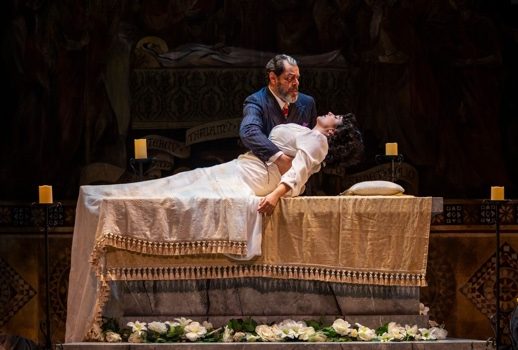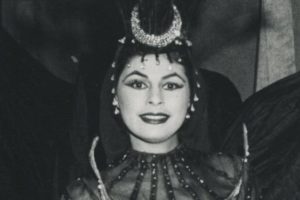

Bier me.
As far as prewar Italian verismo goes, L’amore dei tre re is a supernova.
Premiering in April 1914, the chef-d’oeuvre of Veronese composer Italo Montemezzi dazzled Toscanini, who would bring it to New York and become its champion. The opera exploded in popularity there, even joining the staple repertoire for a few decades. Then, a decade after World War II, it suddenly lost traction, and poofed quietly into obscurity.
What happened? Last night, intrepid New York City Opera endeavored to find out, resurrecting the work for a woefully short weekend run at Jazz at Lincoln Center. Despite its imperfections, what stood out in NYCO’s production was the brutish glory of a fallen star: a storyline that somehow treads both fantasy romance and emotional depth, a juicy bass part, and the composer’s frank, clairvoyant flair for musical drama.
L’amore follows the trials of a blind medieval baron as he struggles to maintain a foothold over his fief. Hoping to boost cultural influence in the conquered Italian land of Altura, Archibaldo has married his earnest son Manfredo to a local princess, Fiora; but she’s far from faithful, choosing instead to host regular evening trysts with her lover Avito, former prince of Altura, whenever Manfredo’s away.
In this kingdom ruled by the blind, it seems everyone sees something the king doesn’t. His servant Flaminio is in fact a double agent, assisting so many assignations between the adulterous lovers he’s practically a madame. It’s also clear that his subjects’ loyalties tend to skew Alturan, not Germanic, and Archibaldo’s influence in the kingdom is but a superficial one.
As if by magic, tensions between German and Italian influence are resolved by Montemezzi’s lush, imaginative score. With its nods to Puccinian vocal line, Verdian tragedy, and Wagner’s harmonic symbolism (all equally popular at the time the opera was introduced), the work is unusual in that it obliges the listener to attend to two operatic traditions at once; it should surprise no one that in 1915, despite its runaway success in America, critics were completely divided over the opera’s merits.
“It is not an opera likely to become widely popular,” wrote Richard Aldrich for The New York Timesa year after its debut at the Met. Though he appreciated its structure, Aldrich ultimately worried L’amorewas too conservative score-wise to sustain much interest.
I found the opposite to be true. Its libretto by playwright Sem Benelli doesn’t stint on overcooked clichés—I could do without another stilted metaphor about the horizon, or the skies for that matter. But the music, alternately swoony and propulsive, generally accomplishes what words don’t.
I was blown away, for instance, by the act two love duet between Avito and Fiora, in which florid Italianate pledges grow increasingly fervent and upset, so that only the orchestra—rushing in aus fernem Meer, pooling around them, striking them both silent—can lend proper expression to their angst. (NYCO’s orchestra would do well to check its dynamics, but conductor Pacien Mazagatti paced the work nicely overall.)
If anything, my suspicion is that if the opera has stumbled historically, it may be because of its unusual chamber structure—not many parts, and the soprano goes mute in the third act—as well as its uncommon demand for a leading bass who can give emotional depth to an archetype as old as Rigoletto.
Samuel Ramey was the most recent exponent of Archibaldo in New York, for City Opera’s 1982 production. For this revival, we get to watch Philip Cokorinos stumble around the steps of the castle. A little past his prime vocally, Cokorinos acquitted himself well enough in the emotionally complex role of a pathetic king whose achilles heel, and eventual undoing, lie in his psychosexual longing for fatherly control over a daughter-in-law. Like the rest of the cast, he was best in act two, when he clomped up a flight of stairs in pursuit of Fiora; I admired his ability to play blind and also commit aggravated assault.
As Fiora, Italian soprano Daria Masiero left more to be desired. She certainly looked the part, a kind of Elizabeth Taylor type with a pinch of Lollobrigada, but the voice warbled sharp up top and gurgled all but inaudible down below, and the face was a vacant hotel room throughout the show. A true shame, as the score reserves some of its richest, most nuanced opportunities for verismo emoting for the doomed princess.
Yet one rarely knew where Masiero was at emotionally, she often stared unblinkingly into space, which had the simplistic effect of rendering her character a witless doormat (hint: Fiora is not a doormat) and dampening what could have been a psychologically nuanced first act.
As her respective paramours Manfredo and Avito, Joo Won Kang and Raffaele Abete proved more than adept at handling the heroic twists of the writing. Abete is not the subtlest of tenors, with a voice that grows a bit shouty near the higher end of the staff. He has, however, the ferret face of a Sirkian leading man, and he gave great poignancy to Avito’s third-act despondence. (Those hoping for a different portrayal can always show up for performances on the 13th and 15th, when Giuseppe Varano takes over the role.)
Kang’s easy, resonant baritone was for me more of a revelation. While Manfredo could easily be played as straight-naive, Kang shaded the cucked prince with moments of great beauty, so that what could have been a stock bobble-head transformed into a sympathetic loser. The voice is pure and sparkling, which made him an attractive alternative for the princess and added unusual depth to the politics underlying her devotion to the Alturans.
I’m no purist, but what made an otherwise worthwhile production more problematic in my view was its decision to futz around with the styling. Audience was left feeling as in the dark as the baron as to why costumes and styling might appear straight out of the 1940s and 50s. (Perhaps a nod to the era when the opera lost its appeal? Unclear.)
Costumer Janet O’Neill draped Fiora in white satin and diamonds, suspendered Alex Richardson as Flaminio, threw 20th century officer uniforms at the princes, and cloaked Archibaldo in a smoking jacket—all pardonable choices, except it seemed her telegrams to set designer David P. Gordon must’ve gotten mixed up in the mail. Evoking turreted medieval fortresses and a lavish frescoed crypt in the last act, sets were gorgeous if incongruous, like if Seventh Seal were directed by George Cukor.
But alas, NYCO’s Michael Capasso is a far cry from Cukor. He staged the action stiffly and awkwardly, a flaw especially evident at the end of acts two and three, betraying, not for the first time, a tin ear for nuance. Here, he often plays up the melodrama but overlooks the opera’s surprising naturalistic turns. Too often in this production symbolic interludes were denied compelling movement onstage; or else, they were missed entirely. Just when we might see the expression of Fiora as she bids farewell to her husband before another assignation, for example, he turns her to face upstage.
Misdirection and odd interpretive creative design aside, this is a rare revival not to be missed. In a perfect world, we’d get another weekend of it; I take solace in the fact that it takes but a single well-intentioned production to open our eyes to the work’s potential.
Photo: Sarah Shatz























Comments